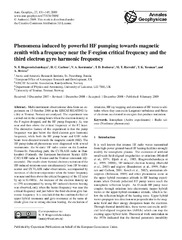| dc.contributor.author | Brekke, Asgeir | |
| dc.contributor.author | Blagoveshchenskaya, N. F. | |
| dc.contributor.author | Carlson, H. C. | |
| dc.contributor.author | Kornienko, V. A. | |
| dc.contributor.author | Borisova, T. D. | |
| dc.contributor.author | Rietveld, M. T. | |
| dc.contributor.author | Yeoman, T. K. | |
| dc.date.accessioned | 2010-02-11T13:06:28Z | |
| dc.date.available | 2010-02-11T13:06:28Z | |
| dc.date.issued | 2009-01-08 | |
| dc.description.abstract | Multi-instrument observational data from an experiment on 13 October 2006 at the EISCAT/HEATING facility at Tromsø, Norway are analysed. The experiment was carried out in the evening hours when the electron density in the F-region dropped, and the HF pump frequency fH was near and then above the critical frequency of the F2 layer.
The distinctive feature of this experiment is that the pump frequency was just below the third electron gyro harmonic frequency, while both the HF pump beam and UHF radar
beam were directed towards the magnetic zenith (MZ). The HF pump-induced phenomena were diagnosed with several instruments: the bi-static HF radio scatter on the London-
Tromsø-St. Petersburg path, the CUTLASS radar in Hankasalmi (Finland), the European Incoherent Scatter (EISCAT) UHF radar at Tromsø and the Tromsø ionosonde (dynasonde).
The results show thermal electron excitation of the HF-induced striations seen simultaneously from HF bi-static scatter and CUTLASS radar observations, accompanied by
increases of electron temperature when the heater frequency was near and then above the critical frequency of the F2 layer
by up to 0.4 MHz. An increase of the electron density up to 25% accompanied by strong HF-induced electron heating
was observed, only when the heater frequency was near the critical frequency and just below the third electron gyro harmonic
frequency. It is concluded that the combined effect of upper hybrid resonance and gyro resonance at the same altitude gives rise to strong electron heating, the excitation ofstriations, HF ray trapping and extension of HF waves to altitudes where they can excite Langmuir turbulence and fluxes
of electrons accelerated to energies that produce ionization. | en |
| dc.description | This is the publisher’s version/PDF (published in Annales Geophysicae, an open access journal of the European Geosciences Union) | en |
| dc.format.extent | 1432592 bytes | |
| dc.format.mimetype | application/pdf | |
| dc.identifier.citation | Annales Geophysicae, 27, 131–145, 2009 | en |
| dc.identifier.issn | 0992-7689 | |
| dc.identifier.uri | https://hdl.handle.net/10037/2384 | |
| dc.identifier.urn | URN:NBN:no-uit_munin_2134 | |
| dc.language.iso | eng | en |
| dc.publisher | Copernicus Publications on behalf of the European Geosciences Union | en |
| dc.rights.accessRights | openAccess | |
| dc.subject | VDP::Mathematics and natural science: 400::Physics: 430::Electronics: 435 | en |
| dc.subject | Ionosphere | en |
| dc.subject | Active experiments | en |
| dc.subject | Radio science | en |
| dc.subject | Nonlinear phenomena | en |
| dc.subject | VDP::Mathematics and natural science: 400::Physics: 430::Electromagnetism, acoustics, optics: 434 | en |
| dc.title | Phenomena induced by powerful HF pumping towards magnetic
zenith with a frequency near the F-region critical frequency and the
third electron gyro harmonic frequency | en |
| dc.type | Journal article | en |
| dc.type | Tidsskriftartikkel | en |
| dc.type | Peer reviewed | en |


 English
English norsk
norsk